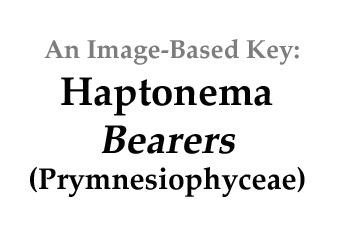


The Prymnesiophyceae are characterized partly by sub-light-microscopic features, including plastids surrounded by four layers of membrane indicating a history of successive “packaging” by endocytosis. Thylakoids are stacked in triplets, chlorophyll is both a and c, and the storage reserve is chrysolaminarin. Other classes (Eustigmatophyceae, Raphidiophyceae, and Tribophyceae) share all these features.
The name "Prymnesiophyceae" was established by Hibberd (1976) to satisfy the International Code of Botanical Nomenclature by using the root of a genus (with the use of Prymnesium in this case). The previous name "Haptophyceae" (Christensen 1962) was based on the presence of an appendage unique to this protistan class, located between the flagella that superficially resembles them, the haptonema that has no homologue outside the class. Various species have differing lengths and flexibilities of haptonemas, and their function also varies from grasping objects to none observed.
Most species are marine (~300), fewer than 10 are in freshwater. Freshwater habitats include lakes with low conductance. Blooms have occurred after loading of organic solutes (human sewage) in a New Hampshire lake.
Some genera including the coccolithophores and Phaeocystis are strictly marine plankters.
References:
Christensen, T. 1962. Alger, in: Böcher, T.W., Lange, M., Sørensen, T., Eds., Botanik, Vol. 2. Systematisk botanic. Munksgaard, Copenhagen (178 p.).
Hibberd, D.J. 1976. The ultrastructure and taxonomy of the Chrysophyceae and Prymnesiophyceae (Prymnesiophyceae): A survey with some new observations on the ultrastructure of the Chrysophyceae. Bot. J. Linnean Soc. 72:55-80.










